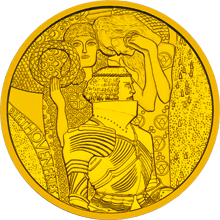Beethoven Frieze
[2] The frieze combined Ancient Greek, Byzantine, early medieval, and Japanese art styles, while incorporating Klimt's characteristic use of gold leaf.The middle panel displays personified threats to the striving (imagined as male) individual, such as lust and sexuality's then feared consequence: syphilis.In appreciation for preserving his work, Klimt provided Reininghaus with over 100 preparatory sketches, one of which was sold to the Museum of Fine Arts, Boston in 1964.[8] During the 1938 German annexation of Austria, the widowed Serena Lederer was forced to abandon her art collection as she fled to Hungary to avoid Nazi persecution for her Jewish origin.[8] In 1973, Erich sold the frieze for $750,000 (half of its purported market value) to the Austrian government in exchange for Chancellor Bruno Kreisky granting export licenses for the Lederer family's other Klimt pieces.
Gustav KlimtCharcoalgraphitemother-of-pearlsemi-precious stonesSecession BuildingViennaVienna SecessionLudwig van Beethoven'sMax KlingerfriezeRichard WagnerBeethoven'sNinth symphonyAncient GreekByzantineearly medievalJapanesegold leafknightsyphilisPicasso'sLes Demoiselles d’Avignonchoir singingTyphonGorgonsMuseum of Fine Arts, BostonAugust LedererSerenaGerman annexation of AustriaAllied forcesmarket valueChancellorBruno KreiskyFederal Monuments OfficeÖsterreichische Galerie BelvedereList of paintings by Gustav KlimtTaschenThe New York TimesJ. Paul Getty MuseumWayback MachineKhan AcademyList of paintingsSchubert at the PianoJudith and the Head of HolofernesInsel im AtterseeBirnbaumHope IThe Three Ages of WomanDanaëPortrait of Adele Bloch-Bauer IWater Serpents IIHope IIThe KissSchloss by the WaterThe Tree of Life, Stoclet FriezePortrait of Adele Bloch-Bauer IIThe MaidenDeath and LifePortrait of a LadyWomen FriendsPortrait of Fräulein LieserPortrait of Johanna StaudeLady with a FanKlimt University of Vienna Ceiling PaintingsStoclet FriezeKlimt VillaErnst Klimt (brother)Emilie Louise Flöge (life companion)Bride of the WindStealing KlimtWoman in GoldLudwig van BeethovenList of compositionsBirthplaceRelationship with contemporariesMozartHeiligenstadt TestamentImmortal BelovedConcert of 22 December 1808Relationship with C minorCollected editionMusical styleCompositional methodWorks catalogsBiamonti CatalogueBeethoven HallBeethovenhalleBeethoven HouseList of sculpturesBerlinMexico CityNew York and San FranciscoMähler's portraitsBeethoven with the Manuscript of the Missa SolemnisEroicaCopying BeethovenOther filmsJohannKasparLudwigJohanna1815 BeethovenBirthplace of Beethoven's motherBeethoven PeninsulaBeethoven quadrangleBeethoven craterBeethoven BurstBeethoven Project TrioBeethoven Quartet SocietyBritish première of Symphony No. 9Eroica PeninsulaIra F. Brilliant Center for Beethoven StudiesThree BsJosef Maria AuchentallerWilhelm BernatzikAdolf Michael BoehmLeopold ForstnerJosef HoffmannMax KurzweilMaximilian LenzMaximilian LiebenweinCarl MollKoloman MoserJoseph Maria OlbrichAlfred Roller